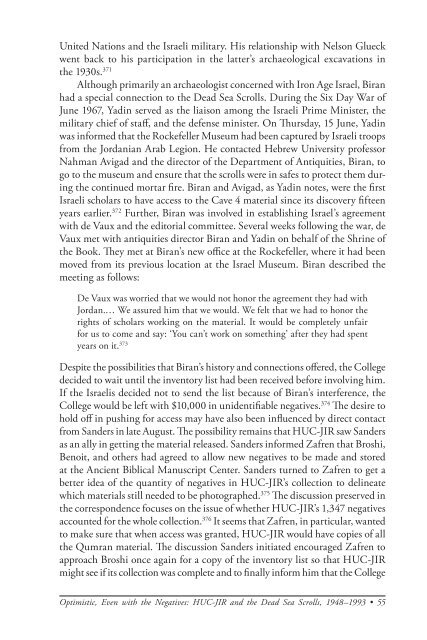The American Jewish Archives Journal, Volume LXI 2009, Number 1
The American Jewish Archives Journal, Volume LXI 2009, Number 1
The American Jewish Archives Journal, Volume LXI 2009, Number 1
Create successful ePaper yourself
Turn your PDF publications into a flip-book with our unique Google optimized e-Paper software.
United Nations and the Israeli military. His relationship with Nelson Glueck<br />
went back to his participation in the latter’s archaeological excavations in<br />
the 1930s. 371<br />
Although primarily an archaeologist concerned with Iron Age Israel, Biran<br />
had a special connection to the Dead Sea Scrolls. During the Six Day War of<br />
June 1967, Yadin served as the liaison among the Israeli Prime Minister, the<br />
military chief of staff, and the defense minister. On Thursday, 15 June, Yadin<br />
was informed that the Rockefeller Museum had been captured by Israeli troops<br />
from the Jordanian Arab Legion. He contacted Hebrew University professor<br />
Nahman Avigad and the director of the Department of Antiquities, Biran, to<br />
go to the museum and ensure that the scrolls were in safes to protect them during<br />
the continued mortar fire. Biran and Avigad, as Yadin notes, were the first<br />
Israeli scholars to have access to the Cave 4 material since its discovery fifteen<br />
years earlier. 372 Further, Biran was involved in establishing Israel’s agreement<br />
with de Vaux and the editorial committee. Several weeks following the war, de<br />
Vaux met with antiquities director Biran and Yadin on behalf of the Shrine of<br />
the Book. <strong>The</strong>y met at Biran’s new office at the Rockefeller, where it had been<br />
moved from its previous location at the Israel Museum. Biran described the<br />
meeting as follows:<br />
De Vaux was worried that we would not honor the agreement they had with<br />
Jordan.… We assured him that we would. We felt that we had to honor the<br />
rights of scholars working on the material. It would be completely unfair<br />
for us to come and say: ‘You can’t work on something’ after they had spent<br />
years on it. 373<br />
Despite the possibilities that Biran’s history and connections offered, the College<br />
decided to wait until the inventory list had been received before involving him.<br />
If the Israelis decided not to send the list because of Biran’s interference, the<br />
College would be left with $10,000 in unidentifiable negatives. 374 <strong>The</strong> desire to<br />
hold off in pushing for access may have also been influenced by direct contact<br />
from Sanders in late August. <strong>The</strong> possibility remains that HUC-JIR saw Sanders<br />
as an ally in getting the material released. Sanders informed Zafren that Broshi,<br />
Benoit, and others had agreed to allow new negatives to be made and stored<br />
at the Ancient Biblical Manuscript Center. Sanders turned to Zafren to get a<br />
better idea of the quantity of negatives in HUC-JIR’s collection to delineate<br />
which materials still needed to be photographed. 375 <strong>The</strong> discussion preserved in<br />
the correspondence focuses on the issue of whether HUC-JIR’s 1,347 negatives<br />
accounted for the whole collection. 376 It seems that Zafren, in particular, wanted<br />
to make sure that when access was granted, HUC-JIR would have copies of all<br />
the Qumran material. <strong>The</strong> discussion Sanders initiated encouraged Zafren to<br />
approach Broshi once again for a copy of the inventory list so that HUC-JIR<br />
might see if its collection was complete and to finally inform him that the College<br />
Optimistic, Even with the Negatives: HUC-JIR and the Dead Sea Scrolls, 1948–1993 • 55

















